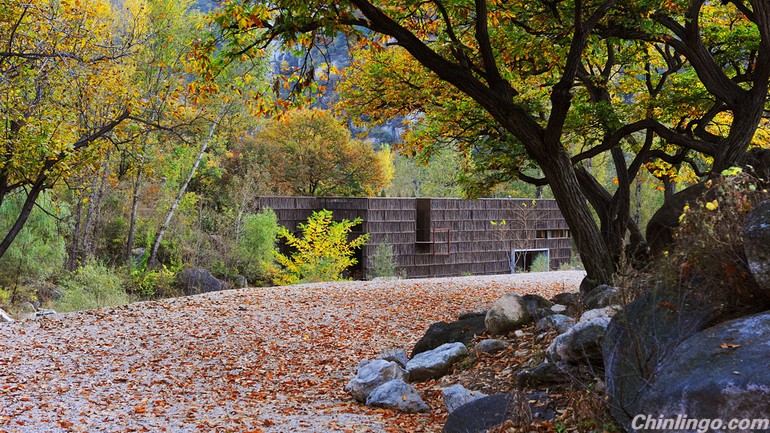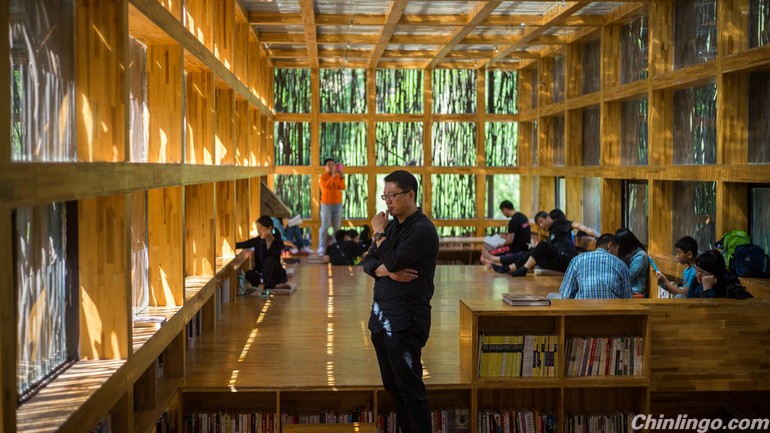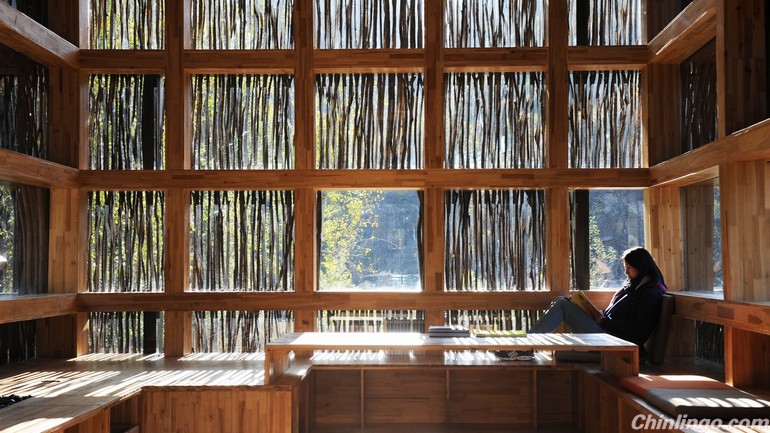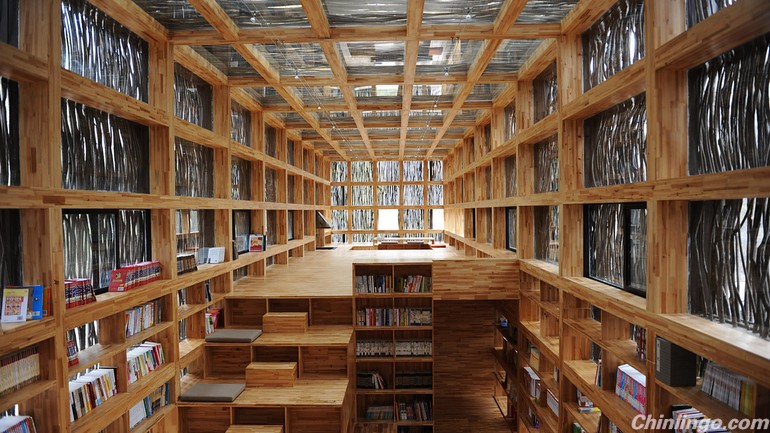JIAOJIEHE, China — Nestled among the shimmering chestnut, walnut and peach trees of a deep valley surrounded by craggy hills, the tiny village of Jiaojiehe suffers from being close to the nation’s capital. The young flee easily to the big city, leaving the elderly behind, lonely and poor.
中国,交界河——交界河村坐落于一个长满栗子树、核桃树和桃树的山谷里,枝叶微光闪烁,四周是陡峭的山峰。因为靠近北京,这个小山村境况不佳,年轻人急于逃离农村去大城市谋生,只剩下老人在这里忍受孤独和贫穷。
In today’s China, villages like this often try to engineer a sense of well-being by opening a new medical clinic, say, or by upgrading the water supply.
在当下的中国,像这样的村子都会通过开设新诊所,或者升级供水系统,来尝试着让人们感到生活水平的提高。
But Li Xiaodong, an award-winning architect who fuses traditional Chinese ideas of design with Western themes, had a different idea for Jiojiehe. He was captivated by the potential he saw in the village’s most abundant natural resource, the branches of its thousands of trees, which the locals harvest for fuel.
但是,屡获殊荣的杰出建筑师李晓东对交界河村有不同的想法。这位擅长把传统的中国设计理念和西方建筑主题融合在一起的建筑师,被这个村子最为丰富的的自然资源吸引,并从中看到了潜力。这种资源就是树枝,来自该村的成千上万棵树木。村民通常收集树枝作为柴火。
So he built a library — with a twist. At its base, it is a steel and glass box in the vein of a Philip Johnson open-plan creation from the 1950s, but its exterior walls and roof are clad with fruit-tree twigs.
所以,他用这些树枝建了一座图书馆。这座图书馆并不像看上去那么简单,其底部是钢筋和玻璃材质的箱体结构,与菲力普·约翰逊(Philip Johnson)在上世纪50年代建造的开放式建筑颇为相似。不过,图书馆的外墙和屋顶上盖满了果树上采集来的树枝。

The spindly sticks are arranged in vertical rows, and their uneven shapes allow natural light to filter into the library’s reading room, while keeping the building cool in the summer and cozy in the winter. They also act as a kind of camouflage, making the library’s rectangular edges barely noticeable in the landscape as visitors approach the village on a narrow, twisting road.
这些细长的树枝都是垂直排列,它们参差的形状形成的空隙,使自然光能够进来,照射在阅览室内,同时又能让图书馆冬暖夏凉。这些枝桠还像是一种伪装,当游客沿着一条狭窄而弯曲的小路走近这个小山村,几乎注意不到图书馆的矩形边角。
The interior of the Liyuan library is basically just one large, casual room, lined with open bookshelves and an eclectic collection of works that include President Obama’s “The Audacity of Hope,” “Forrest Gump” and traditional Chinese novels about the Qing dynasty. There are no chairs or desks, just a polished wood floor with several elevated platforms where readers can lounge with their books.
篱苑书屋的内部基本上就是一个颇为随意的大开间,摆满开放式书架。其藏书可谓五花八门,既有奥巴马的《无畏的希望》(The Audacity of Hope),又有《阿甘正传》(Forrest Gump),还有关于清朝的中文小说。图书馆里没有桌子,也没有椅子,抛过光的木地板有好几个阶梯状的平台,读者可以坐在上面闲适地看书。
Meeting the reading needs of the roughly 50 households that remain in the village is something of a sideline, though. What the building is mainly meant to be is a magnet for day-trippers from Beijing, eager to escape the city’s perpetual smog and dirt for a bit of beauty and calm.
不过,满足留在村中大约50户人家的阅读需求只算是它的副业。建这个书屋主要是吸引从北京来的一日游游客,这些人渴望逃离北京无时不在的雾霾和灰尘,寻找片刻美丽与平静。

“The library is a tool to attract people to the village,” said Mr. Li, a professor of architecture at Tsinghua University in Beijing.
“书屋是一个吸引人们来村里旅游的工具,”李晓东说,他也是北京清华大学的建筑学教授。
When visitors come to see the library, he said, they also spend money at the village’s few restaurants, pay parking fees and donate money for the building’s upkeep.
他表示,当游客来看书屋的时候,会在村里的餐馆消费,付停车费,也会为这座建筑的维护捐款。
“The place is special,” said Li Wenli, 45, an insurance saleswoman from Beijing who sat in a corner of the reading room with a large book balanced on her knees as her 9-year-old son read along with her.
“这个地方很特别,”45岁的李文丽(音)说。她是来自北京的保险销售员,坐在阅览室的一个角落里,膝盖上平摊着一本大书,正和九岁的儿子一起看。
“In the city, a library seems to be unnaturally quiet,” she said. “You think: ‘I need to stay quiet because everybody else is quiet.’ But here, the peace is natural.”
“在城市里,图书馆好像安静得不自然,”她说。“你会想:‘我需要保持安静,因为其他人都很安静。’但在这里,这种平静是自然而然的。”
The library has a presence on social media, and many of the visitors on the weekend are university students or young professionals. They wander around the village, snap photos of themselves and order the local delicacy, stewed chicken with chestnuts, at one of the restaurants.
图书馆也经常出现在社交媒体上,许多周末来的游客都是大学生或者年轻的上班族。他们在村庄里漫步,给自己拍几张照片,还会在村里的餐馆点上一盘当地的佳肴栗子炖鸡。
And some of them actually read. Sun Liyang, 27, an automotive journalist, said a friend in Beijing had donated some books after hearing about the library online, and he decided to come for a look. “I am sitting here reading ‘The Adventures of Tintin,’ ” he said. “It’s taking me back to my childhood.”
他们当中的一些人确实是来读书的。27岁的孙立阳(音)是一名做汽车领域报道的记者,他说他在北京的一个朋友从网上听说这家图书馆后,给这里捐了一些书,而他则决定来这里看看。“我正坐在这儿看《丁丁历险记》呢,”他说道。“它让我想起了自己的童年。”
Wang Fuying, 57, who used to grow crops in the area, is now the librarian, even though she can barely read. “All the library visitors are from the city,” she said. “We have up to 200 visitors a day over the weekend. They come for fun, take a look, take some pictures and take a walk.”
57岁的王福英(音)以前在当地种庄稼,现在她在这个书屋担任图书管理员,尽管她几乎不认识什么字。“来这里的都是城里人,”她说,“周末每天会有200人。他们来这里玩,看一看,拍点照片,散个步什么的。”

There are a few flaws. To preserve the wood floor, patrons must remove their shoes at the front door, but in the summer when there are many visitors, the reading room becomes smelly from all the socks, Ms. Wang said. The wood-burning fireplace looks like an inviting place for winter reading, but it was placed too close to the windows and has proved to be unusable.
有一些不如意的地方。王福英说为了保护木地板,顾客必须在门口脱掉鞋子,但夏天游客很多,脱了鞋,阅览室里味道就会比较大。烧柴的壁炉看起来是个适合冬天里阅读的好地方,但因为设计得离窗口太近,结果也没法用。
But those are small things compared with the good the building has done for the village. Its two small restaurants “would have closed without the visitors,” Ms. Wang said.
但是,相比于它给这个村子带来的好处,这些都是小事。村里的两个小饭馆“要是没有游客早就关门了,”王福英说。
Mr. Li, the architect, who is 52, graduated from Tsinghua University in 1984, in one of the first classes of young designers to emerge after the disaster of the Cultural Revolution. He went to the Netherlands to study the history and theory of site planning, received a doctorate in 1994 and taught in Singapore before returning to join the faculty of the lively architecture school at Tsinghua.
篱苑书屋的建筑师、52岁的李晓东,1984年毕业于清华大学,他所在的班级培养了文革浩劫后中国第一批年轻建筑设计师。后来他去荷兰学习了景观规划的历史和理论,1994年获得博士学位,而后曾在新加坡任教,直到回国进入充满生气的清华大学建筑学院。
There he refines ideas that he said were influenced by Frank Lloyd Wright, and are based on the tenet that buildings should be integral parts of the landscape and not objects placed in it.
他在那里完善了他的一些想法,他说这些想法受到了弗兰克·劳埃德·赖特(Frank Lloyd Wright)影响,基本原则是:建筑应该是自然环境不可分割的一部分,而不是放在环境中的一个物体。
“Chinese architecture is always drawn from a bird’s-eye view, never from the human eye,” he said. “We always think of architecture as one piece. We don’t see the human as detached from the environment.”
“中国建筑多数是从鸟瞰的视角着手,而不是人的视角来设计的,”他说。“我们一向认为建筑是一个整体。我们不认为人类与环境是分开的。”

Mr. Li's projects in other parts of China where he has built small structures in rural areas — including a school built high over a creek — have won many prizes. But few honors seem to have pleased him more than last year’s Moriyama R.A.I.C. International Prize, named for the Canadian-Japanese architect Raymond Moriyama. It honors projects that are “transformative, inspired as well as inspiring, and emblematic of the human values of respect and inclusiveness.”
李晓东在中国其他地方的农村地区建造了一些小型建筑。他在这些地方的项目——其中包括一所建在一条小河上的学校——获了很多奖项。但去年的“森山-加拿大皇家建筑协会国际奖”(Moriyama R.A.I.C. International Prize)似乎格外让他开心。该奖以加拿大籍日裔建筑师雷蒙·森山(Raymond Moriyama)命名,表彰那些“具有变革性、创造性和启发性,而且能体现人类价值观的尊重与包容的”项目。
On a recent weekend, Mr. Moriyama, 85, was one of the visitors to the library. He liked what he saw. “I was so happy this particular project won,” he said. “It was all about picking one that represents service to the people. The sense of humanity of the library is so great.”
近期的一个周末,85岁的森山与其他参观者一同来到篱苑书屋。他喜欢自己眼前的建筑。“这个特别的建筑能获奖,我非常开心,”他说。“这个奖的目的,就是挑选出一个能代表为人服务的精神的建筑。这座图书馆的人文感非常棒。”
The older architect patted Mr. Li on the back. “You did good,” he said. “I was not on the jury, and quite often, I disagree with the jury. But in this case, I believe it was 150 percent right.”
这位老建筑师拍了拍李晓东的后背。“你做得非常好,”他说。“我不是评委,而且我经常不同意他们的决定。但是这一次,我认为他们的决定150%的正确。”



 闽公网安备 35020302035673号
闽公网安备 35020302035673号
0 responses on "Liyuan Library - a Moriyama RAIC winner that integrates architecture with nature"